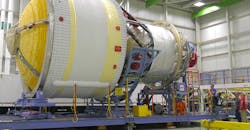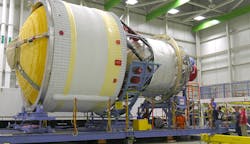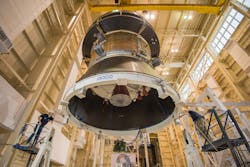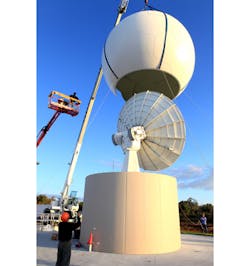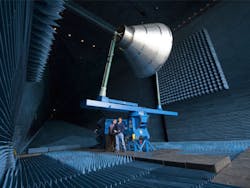Each administration puts its own inflection on the U.S. space program. Some presidents set goals that ultimately change the destiny of the country, while others promote changes that are less dramatic.
It’s too early to tell what mark the current administration will leave on the space program. But initial remarks and actions suggest two major priorities.
The first represents a change from past administrations by shifting NASA budgets to deep space goals, and away from Earth science and climate research.
The second priority is really a continuation from previous administrations—namely, ceding more NASA-controlled activities in low-Earth orbit to commercial space companies such as SpaceX, Boeing, and Orbital ATK. In the future, more commercial firms will deliver cargo and, eventually, humans to the International Space Station. This shift highlights the ongoing privatization move from “old space” (NASA) to “new space” (commercial firms).
This privatization of low-Earth orbit activities highlights the budgetary challenges that NASA continues to face. The monetary shortfall was brought to the nation’s attention a few months ago when NASA's chief of human spaceflight, Bill Gerstenmaier, speaking to the American Institute for Aeronautics and Astronautics, admitted that he couldn’t put a date on humans exploration of Mars because the funding level was too low.
This doesn’t mean that NASA isn’t working on the technology for a manned Mars mission. Current budgets include continuing development of the Space Launch System and spacecraft Orion (more on these shortly). But the agency also needs to design landing vehicles to actually get to and from the surface of the red planet.
Further, budget cuts from other programs—such as Earth and climate research—may not really result in savings that could be used on the deep space programs. Additionally, such cuts may present a logistical nightmare. For example, how does one turn off NASA’s 16-plus earth science satellites currently in orbit that collect not only climate data, but also information on oceans and wildfires? Nor would it be easy to transfer these satellites to other agencies, as the satellites are operated by contractors under traditional five-year service agreements.
Technical Relevance
Shifting priorities and limited funding aside, what does the new direction for NASA mean to the RF/microwave community?
Privatization of low-earth orbit systems to commercial contractors will place a premium on efficiency and profitability of design, maintainability, and operations.
One supplier of low-earth orbit satellites suggested the importance of specific RF technology in a recent IEEE IMS panel on the Internet of Space. “We have looked heavily at a lot of different silicon technologies, especially GaN and GaS chip technologies,” David Bettinger, VP of Engineering, Communications Systems, Oneweb. “We are utilizing low-noise amplifiers (LNAs) and up/down converters, among other components.” The key trade-offs he noted were between power, mass, performance efficiency, and cost.
Deep space technology presents more systematic challenges. The two main ongoing NASA activities are the Space Launch System (SLS) and the Orion capsule. The space launch system (SLS) will be the most powerful rocket we’ve ever built, suitable for a manned travel mission to Mars. The addition of a fifth propellant segment to the former four-segment shuttle booster allows the new launcher to lift more weight than the shuttle (Fig. 1).
Technology improvements to the solid rocket booster include:
- 25% more propellant.
- A new nozzle design.
- A new asbestos-free insulation and liner configuration.
- New avionics . The booster forward skirt houses booster avionics that communicate with the SLS avionics to monitor booster conditions and steer the booster exhaust nozzle.
- An improved nondestructive evaluation processes.
Improvements are also being made to the Orion spacecraft, the main crew module propelled by the SLS. NASA hasn’t shared much about the technology inside the Orion (Fig. 2). Instead, it has listed improvements to basic subsystems:
- Environmental control and life support systems
- Radiation protection
- Power and propulsion
- Heat shield
- Parachutes
Ground Station Tech and Cube Satellites
Of greater potential interest to RF/microwave engineers are the new S-band tracking stations, which will provide the latest technology for SLS and the Orion (Fig. 3). For example, the new SLS rocket will transmit multiple streams of telemetry to the ground at a much higher data rate (recall the new avionics mentioned above). Further, for communication with the Orion capsule astronauts, the ground station must receive and transmit S-band data.
To improve RF performance in space, a full-scale Orion model is undergoing performance and EM radiation pattern testing with a number of traditional antennas (Fig. 4). The frequency range of this activity spans from 200 MHz to 40 GHz.
Not mentioned as part of the new tech gear on the Orion, but still undergoing research at NASA, is a high-precision laser communication system that will eventually complement existing RF systems. This technology will be critical for future deep-space missions.
Finally, an unusual trio of do-it-yourself (DIY) satellites will be included on NASA’s first flight of Orion/SLS. Three small spacecrafts, known as CubSats, will be included on first launch or Exploration Mission-1. The three CubeSats will be tucked into the Orion stage adapter—the ring that connects Orion to the SLS rocket. Once deployed after the Orion spacecraft separates from the SLS, the CubeSats will journey into deep space to advance the understanding of propulsion and communication technologies.
One of the CubeSats was developed by engineering students at the University of Colorado, Boulder. It will test various communication technologies in deep space (Fig. 5). The shoebox-sized CU Earth Escape Explorer (CU-E3) will be testing for the largest aggregate data volume, the most error-free data blocks, the most distant communications from Earth, and spacecraft longevity. It will be using a novel planar antenna designed to enable high data rate transmissions.
Summary
Under President Trump’s administration, the priorities for the U.S. space program will probably be to privatize low-Earth satellite systems and continue the work of early presidents to develop deep space rockets and spacecraft. These priorities will encourage more efficient and economical RF and microwave designs, as well as encourage higher data rate technology and further communication research.
